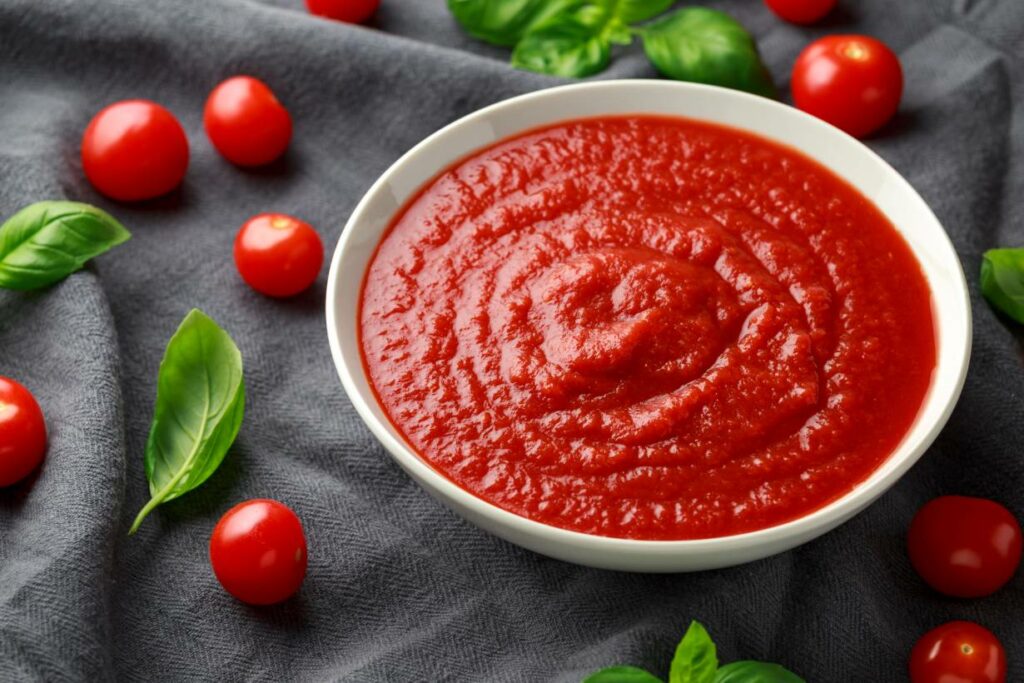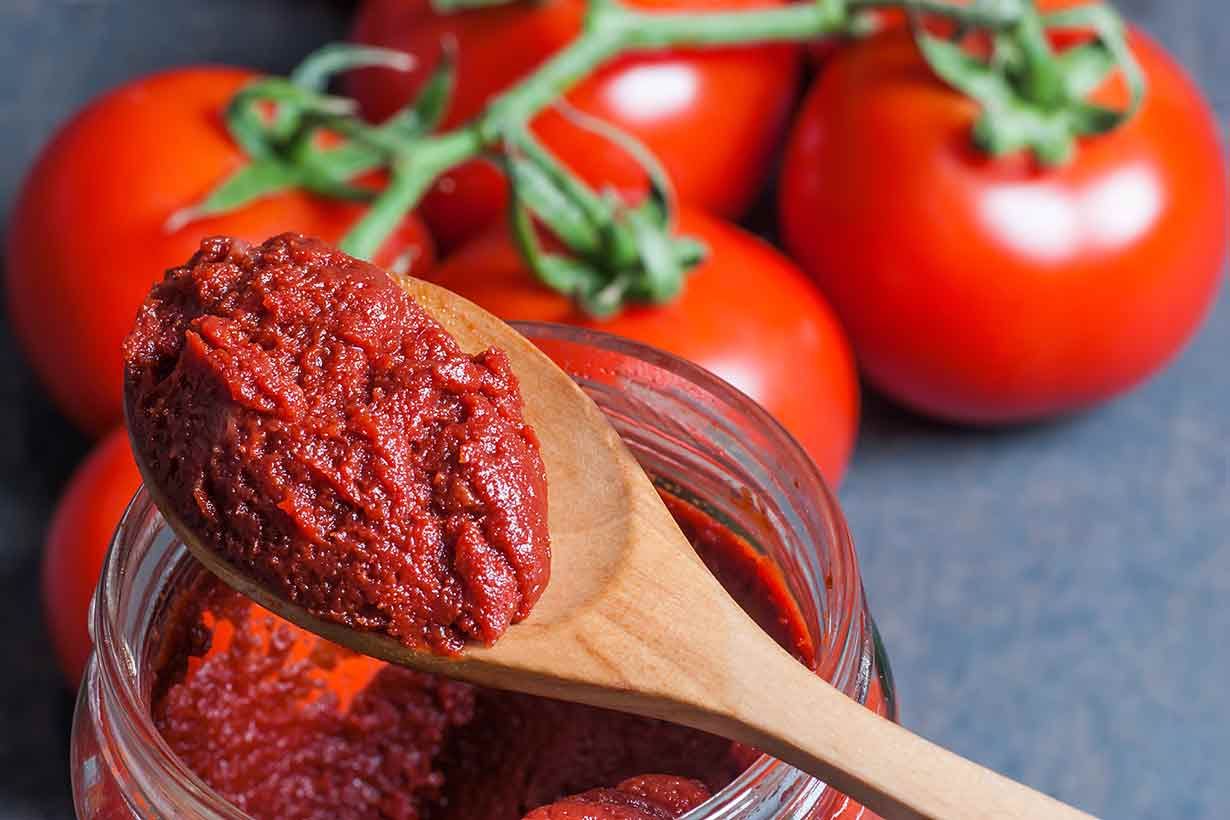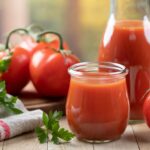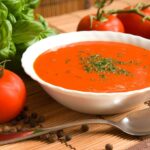Tomato passata is a nutrient-rich and flavorful product made from fresh tomatoes.
This article examines how passata compares to other tomato products, its nutritional benefits, and how to use it.
Table of contents
What Is Tomato Passata?

Tomato passata is an Italian name that translates to ‘tomato puree.’
It has different characteristics from other tomato-based products.
For one thing, passata is just 100% pure fresh, uncooked tomatoes that have been pureed and strained.
Unlike most tomato-based sauces, passata usually does not contain additional ingredients. However, some products may contain added salt.
There are many different uses for passata. For instance, it can be used as a base for a homemade sauce or as a flavor-enhancing ingredient in many recipes.
How Is It Made?
Based on the process a large producer of tomato passata follows, here is a quick summary of how passata is made:
- Firstly, ripe tomatoes of high quality and flavor are selected and hand-harvested.
- After an inspection, the tomatoes are pureed and strained to remove their skins and seeds.
- Following the straining, an evaporator thickens the resulting tomato liquid. This reduces the water content and results in ‘passata’ with a thicker texture.
Most commercial passata is for sale in glass jars or cartons.
Nutritional Profile
Tomato passata provides a more concentrated source of the nutrients in tomatoes.
In this section, we will examine the typical nutritional values of passata using nutrition data from the NCC Food and Nutrient Database (1).
The listed daily values are calculated using this nutritional data and the FDA’s recommended daily values (1, 2).
Nutrition Facts
Here are the nutritional values for tomato passata per 250-gram cup serving.
| Name | Amount | % Daily Value |
|---|---|---|
| Calories | 95 kcal | |
| Carbohydrates | 22.45 g | 8.2% DV |
| Fiber | 4.75 g | 17.0% DV |
| Sugars | 12.07 g | |
| Fat | 0.53 g | 0.7% DV |
| Saturated | 0.07 g | 0.4% DV |
| Monounsaturated | 0.08 g | |
| Polyunsaturated | 0.22 g | |
| Omega-3 | 0.01 g | |
| Omega-6 | 0.00 g | |
| Protein | 4.12 g | 8% DV |
| Cholesterol | 0 mg | 0% DV |
Vitamins
- Vitamin E: 32.5% DV
- Vitamin C: 29.4% DV
- Vitamin B3 (niacin): 22.9% DV
- Vitamin B5 (pantothenic acid): 22% DV
- Vitamin B2 (riboflavin): 15.4% DV
- Choline: 8% DV
- Vitamin A, RAE: 7.1% DV
- Vitamin K: 7.1% DV
- Folate: 6.9% DV
- Vitamin B1 (thiamin): 0.1% DV
As we can see, passata is an excellent source of vitamins C, E, and several B vitamins.
Minerals
- Copper: 80% DV
- Sodium: 38.8% DV
- Iron: 24.7% DV
- Potassium: 23.4% DV
- Manganese: 18.3% DV
- Magnesium: 13.7% DV
- Zinc: 8.2% DV
- Phosphorus: 8% DV
- Selenium: 3.2% DV
- Calcium: 3.5% DV
As well as being a significant source of copper, passata also offers reasonable amounts of iron, potassium, manganese, and magnesium.
If salt has been added, passata products may also have a high sodium content.
Other
- Passata is approximately 88% water by weight.
- Like all tomato products, passata is a significant source of the carotenoid lycopene. A 250-gram cup serving provides 54385 mcg of lycopene.
Benefits
Tomato passata has several benefits relating to its nutritional content and characteristics.
An Excellent Source of Vitamins and Minerals
As previously shown in the nutritional values, a cup of passata provides a broad range of vitamins and minerals for only 95 calories.
Among these micronutrients, it has significant levels of copper (80% DV), vitamin C (29% DV), and vitamin E (33% DV).
Vitamins C and E play an important role in the immune system and help to protect against free radical damage and chronic disease (3, 4).
The body uses copper for numerous functions, including energy production. This mineral also has important roles in the nervous and immune systems (5).
Fiber
A cup of passata offers 4.75 grams of dietary fiber, equal to 17% of the recommended daily value of 28 grams (2).
A 2022 umbrella review examined fifty-two meta-analyses of existing randomized controlled trials on fiber intake and cardiovascular risk factors.
After analyzing the data, the researchers demonstrated that higher dietary fiber intake led to improvements in (6):
- Fasting blood glucose
- Fasting plasma insulin
- Total cholesterol and low-density lipoprotein cholesterol (LDL-C)
Lycopene Content
Like tomato paste, tomato juice, and tomato soup, passata offers a significant source of lycopene.
As listed in the nutritional values, a 250-gram cup of tomato passata contains 54385 mcg of lycopene.
Lycopene is a bioactive carotenoid that gives food a deep red pigment and is thought to have potential health benefits (7).
For example, recent studies have found that:
- Lycopene appears to decrease fasting blood glucose, according to a 2022 systematic review and meta-analysis (8).
- In a 2023 systematic review and meta-analysis of 21 intervention trials, lycopene supplementation lowered markers of UV-induced skin deterioration (9).
- A 2021 systematic review and meta-analysis demonstrated that dietary lycopene intake was associated with a reduced risk of all-cause mortality, prostate cancer, metabolic syndrome, stroke, and cardiovascular disease. However, it is essential to note that the researchers stated that the quality of evidence ranged from ‘very low’ to ‘moderate,’ thus necessitating further research (10).
Notably, the bioavailability of lycopene varies among different tomato products.
In this regard, processed tomato products provide more bioavailable lycopene than whole tomatoes. This is because processing breaks down the cell walls of the tomato, making the lycopene content easier to access and digest (11, 12, 13).
A Healthier Cooking Sauce
Another potential benefit of tomato passata relates to what it is replacing in the diet.
For instance, many popular cooking sauces contain high calorie, fat, sugar, and salt content.
Since many already consume these nutrients in excess, passata can be an excellent swap.
Passata is relatively low in calories, contains no added fat or added sugars, and usually has no added salt (check the label to confirm).
Using passata as a base for a cooking sauce allows us to choose what (and how much) seasonings or oils we want to use.
Also, some people may be discouraged from making a homemade sauce using whole tomatoes due to the extra work involved. However, passata is still 100% tomatoes, and it makes the process easier.
How Does Tomato Passata Compare To Tomato Paste?
Tomato paste is another nutrient-rich, flavor-enhancing tomato product, so how do the two compare?
Firstly, tomato paste is significantly thicker than passata since more of its water content has been removed through evaporation.
Since tomato paste is more concentrated than passata, it has a sweeter taste and a much more robust flavor.
However, for these reasons, it should only be used in relatively small servings.
To compare tomato paste and passata directly, here are their fundamental nutritional values per 100 grams. Passata’s nutritional values come from the NCC data, whereas the USDA is the source of tomato paste’s nutritional data (1, 14).
| Name | Tomato Passata | Tomato Paste |
|---|---|---|
| Calories | 38 kcal | 82 kcal |
| Carbohydrates | 8.98 g | 18.9 g |
| Fiber | 1.90 g | 4.1 g |
| Sugars | 4.83 g | 12.2 g |
| Fat | 0.21 g | 0.47 g |
| Saturated | 0.03 g | 0.1 g |
| Monounsaturated | 0.03 g | 0.07 g |
| Polyunsaturated | 0.09 g | 0.16 g |
| Protein | 1.65 g | 4.32 g |
| Water content | 88% | 74% |
As shown in the table, tomato paste has a higher content of every nutrient because it is a more concentrated form of tomatoes.
To sum up, tomato passata is more suited to being the base for a sauce, whereas tomato paste is an ingredient to add to a dish.
A complete nutritional review of tomato paste is available here.
How Does Passata Compare To Tomato-Based Sauces?
Passata may have a similar texture to tomato-based cooking sauces, though it will likely be a little thicker.
However, as earlier mentioned, most cooking sauces contain various additional ingredients, whereas passata does not.
In this regard, using passata gives you more control over what you want in your cooking sauce.
It is easy to add a little oil, salt, sugar, herbs, or spices to passata, depending on the kind of sauce you prefer.
How To Use Tomato Passata
Tomato passata is a versatile food product.
For some ideas, here are some ways in which we can use it:
- Homemade sauce: add some Italian herbs and spices to make pasta or lasagna sauce, or some curry powder for a homemade curry sauce. Alternatively, use passata as a base and try different sauce recipes creatively.
- Pizza base sauce: passata works well as a sauce for a pizza base. Add a touch of salt, a bit of garlic, and some Italian herbs of your choice, and then spread it on.
- Soups and stews: add a cup of passata to a soup or stew to enhance the flavor (and nutrient profile).
- Tomato soup: pan-fry some vegetables of your choice, add passata, bring to a boil, and then simmer for 5-10 minutes. Season with herbs and spices of your choice, and add a bit of water if necessary to achieve the desired consistency for the soup. Add milk for the last few minutes of cooking if desiring a more traditional, creamier tomato soup.
Common Questions
If there are unresolved questions about tomato passata, here are some answers to frequently asked questions.
Passata is not a direct replacement for tomato paste since the two have entirely different consistencies and strengths of flavor. If a recipe calls for tomato paste, it is possible to use approximately 2-2.5x the amount of passata for a similar taste. However, be aware that passata has a more liquid texture and thus may not be suitable as a substitute in all dishes.
In truth, the nutritional quality of pasta sauces can vary depending on the product. However, passata will almost always contain fewer calories and provide a lower fat, sugar, and sodium content.
Passata is a healthy and nutrient-rich way to consume tomatoes that provides a wide range of vitamins and minerals. Additionally, the lycopene content of passata is more bioavailable than in whole tomatoes. Passata can thus be a nutritious addition to the diet.
All passata contains naturally occurring sugar from the tomatoes it is made from. However, genuine passata does not contain added sugars.
Final Thoughts
Tomato passata is an excellent ingredient to have in the kitchen. Using it is quick and straightforward, and it can be the ‘base’ for various sauces and dishes.
Nutritionally, passata is a rich source of copper, vitamins C and E, and many other vitamins and minerals in smaller amounts.
As a result, using passata in cooking is a simple way to enhance a dish’s flavor and nutrient provision.




